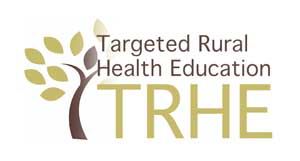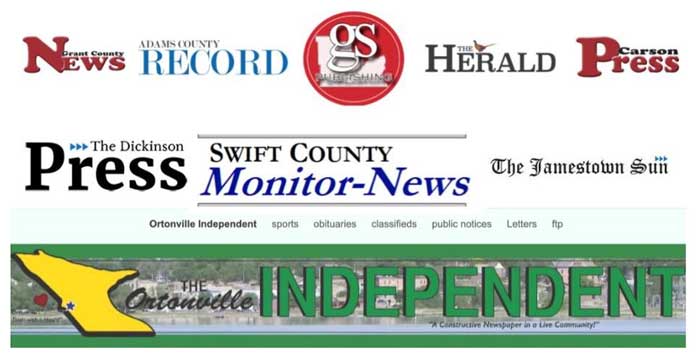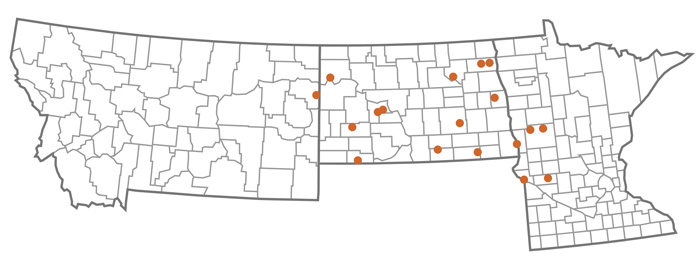Targeted Rural Health Education Project
- Need: Dual platform to teach both plain language use and health literacy principles to health professions students and disseminate health information to rural populations.
- Intervention: Writing project using community-specific public health data in order to write a plain language health education article suitable for publication in a rural newspaper.
- Results: Since program start in 2017, over 60 students have successfully published their plain language health education articles in 17 rural newspapers in 3 states.
Description
 With the
collaborative support of the North Dakota Rural Health
Association (NDRHA), the University of North Dakota
(UND) Center for Rural Health (CRH), and the
UND Department of Family and Community Medicine, the
Targeted Rural
Health Education (TRHE) project introduces medical
students and other University of North Dakota School
of Medicine and Health Sciences (UNDSMHS) health
professions students to health literacy concepts and
tools.
With the
collaborative support of the North Dakota Rural Health
Association (NDRHA), the University of North Dakota
(UND) Center for Rural Health (CRH), and the
UND Department of Family and Community Medicine, the
Targeted Rural
Health Education (TRHE) project introduces medical
students and other University of North Dakota School
of Medicine and Health Sciences (UNDSMHS) health
professions students to health literacy concepts and
tools.
Participants write a newspaper-friendly, data-informed, public health-focused education article that embraces health literacy's emphasis on the use of plain language. Because rural newspapers are important disseminators of information — including health information — rural newspaper editors are the project's strategic partners.
This project aligns with the Office of Disease Prevention and Health Promotion's Healthy People 2030 declaration that health literacy is a "central focus."
The TRHE project was originally designed in 2015 for physician residents in the Family Medicine Residency of Idaho by the current chair of the UND Department of Family and Community Medicine who championed replication in North Dakota. The North Dakota project started in 2017 as an extracurricular activity for medical students completing rural clinical shadowing experiences. The participant pool has expanded to include any medical student completing a rural clinical rotation — and any interested UNDSMHS health profession student. In 2019, TRHE became a mandatory curriculum element for third-year medical students (originally 5 students per semester at project start, now expanded to 10) selected for the longitudinal experience offered by the Rural Opportunities in Medical Education program.

Currently offered to all health profession students, it is word-of-mouth from previous participants that has led other health profession faculty to encourage their students to take advantage of participating in the program in order to disseminate their original research.
Although program coordinators recommend that students select topics based on a review of their community's health needs assessment (CHNA) that identifies their rural community's concerns, chosen topics can include those that repeatedly require education discussions during clinic or hospital visits.
Initial drafts are submitted to the writing mentor who provides one-on-one feedback based on plain language health literacy principles and newspaper style. Final drafts undergo faculty review and approval followed by the project coordinator working with the rural newspaper editors for final publication.
Once published, the students are notified and encouraged to list the publication in their curriculum vitae.
The NDRHA hosts all completed TRHE articles on its website. Newspaper subscriptions allow the project coordinator to track final publication.

Services offered
Publication process:
After topic selection, first drafts are written in any style the student finds most comfortable: for example, clinical peer-to-peer language or a language they might use to educate friends and family. Next, the writing mentor provides detailed feedback on content organization, and the use of plain language principles by email or by virtual meeting. This process continues until the student and the writing mentor have agreed on final draft content. At that point, the project coordinator also reviews the article and forwards it for faculty review. With faculty approval, the project coordinator then networks with the community newspaper leadership for final publication.
Staffing model and staff roles:
Project coordinator
- Promotes TRHE program to medical students
participating in specialized rural health interest groups
- Organizes formal group project introduction for ROME students and individual introduction for other interested students
- Serves as a primary point of contact for interested students
- Establishes relationships with rural community newspaper editors and leaders
- Works with NDRHA website team to post completed articles on NDRHA.org
- Tracks newspaper publication
- Communicates with program faculty regarding progress and status of student articles
- Provides outreach and education to rural communities that have a student on site who is engaged in the TRHE project
- Time commitment: 130 hours/year
- North Dakota example: Role found a natural fit within Center for Rural Health's Workforce Specialist outreach activities
Writing mentor
- Provides individual, specific feedback based on health literacy principles and plain language writing style
- Time commitment: About 20 hours per completed article
- North Dakota example: This position is currently filled by a CRH staff member who is an experienced primary care physician with a journalism degree, extensive rural health writing experience, and graduate medical education teaching experience
- Note: Beneficial core skills for this role:
- Healthcare writing
- Medical education teaching experience
- Patient care experience
- Knowledge of health literacy/plain language writing principles
Faculty reviewers
- Participate in topic choice review
- Provide final draft review for content accuracy and suitability for the student's specific rural community's culture
- Time commitment: About 15-30 minutes per final draft
- North Dakota example: Role found a natural fit for the Family Medicine Clerkship and ROME program co-directors
Newspaper editors
- Review and approve final publication in hard copy and/or online editions of rural community newspapers
Results
Publication
As of January 2024, 60 stories have been published in 17 rural newspapers in 3 states: Minnesota: Benson, Ortonville, Pelican Rapids; Montana: Sidney; North Dakota: Beulah, Devils Lake, Dickinson, Grafton, Hazen, Hettinger, Jamestown, Mayville, Oakes, Park River, Wahpeton, Wishek, Williston.

Student feedback
Because the TRHE project is mandatory for ROME students, TRHE staff recognized the need for formal project feedback. Results from September 2019 through December 2020 were:
- 10 respondents/15 surveyed
- Effective for understanding community needs:
- 8/10 = somewhat
- 2/10 = yes, a lot
- Participation if TRHE were an elective opportunity:
- 5/10 = would participate
- Overall experience
(1=unsatisfactory, 10=excellent):
- 7/10 = rated 8 to 10
- 3/10 = rated 5 to 7
Informal feedback from some students completing TRHE as a mandatory element of their curriculum indicated that although they do not like to write, the project has made them more aware of the importance of health literacy for themselves as well as the community and patients they served.
Feedback from students have included statements such as: "This was a genuinely fun project and as I'm sure you know advocacy is a big thing for me, I feel I learned some solid skills that I'll use in the future."
Due to an increased number of both ROME students and an increase in students interested in TRHE as an extracurricular opportunity, a more formal survey instrument is planned.
Rural newspaper leadership and relationship building
With time, repeated coordination has created a smooth publication process. As a result of early discussions with several rural newspapers, publication now occurs with one email exchange between the project coordinator and the editor.
Although editors are very busy, they at times also provide feedback. Regarding a 2021 TRHE submission, the project coordinator received this comment from a rural editor: This is a fantastic article and one that suits some of the content we've been hyper-focused on here in southwest North Dakota. We've recently completed a series of stories centered on the lack of mental health services in our area and I think this is a great tie-in to that piece. We'll publish this in our print edition, digital e-edition and online at our website.
Hear from TRHE participants and rural newspaper editors in this video:
For more on the program:
Delage, B., Kusler, S., Schmitz, D., Sherman, K., Miller Temple, K. (2019, June 27). Targeted Rural Health Education[Webinar]. Rural PREP.
Kusler, S. Targeted Rural Health Education: A New Writing Project Gives Medical Students a Better Understanding of Rural Community Health Needs. North Dakota Medicine. Fall 2017.
Criswell, W. Bridging gaps in health knowledge through local news. UND Today. July 2023.
Presentations:
Kusler, S., Miller Temple, K. "Targeted Rural Health Education Project." May 2023. Joint North Dakota and South Dakota Newspaper Associations Annual Meeting.
Schmitz, D., Miller Temple, K. Promoting Health Literacy through Culturally and Linguistically Appropriate Services (CLAS). June 2023. CMSHHS.gov video.
Schmitz, D., Miller Temple, K. Meeting Rural Communities Where They Are. November 2023. CMSHHS.gov video.
Challenges
- Students express difficulty in prioritizing writing time during intensive clinical training settings.
- Though the project was initially designed to emphasize a physician's leadership role within a community and the need to network with the community communication leader — the newspaper editor — the idea of having students connect directly with the rural newspaper leadership was abandoned. Both clinical schedules and lack of the project's formal leadership training have precluded that activity, which is now assumed by the project coordinator.
- Finding time and an appropriate setting for project promotion to all UNDSMHS students.
- Because face-to-face relationship building with the rural newspapers is an important part of the student publication process, COVID has impacted rural newspaper outreach.
- There is no formal designated funding stream for the project.
Replication
Replication depends on:
- An organization's ability to flex personnel available
for staffing model
- Note: Model is conducive to smaller or larger scale project
- Ability to provide project information within structured medical school curriculum demands
- Relationship building with rural newspaper leadership
- Continued improvement of current relationships and building new relationships will always be a project focus
TRHE Toolkit (currently being updated) provides further replication details.
Contact Information
Stacy Kusler, BA, CPRP, Workforce SpecialistCenter for Rural Health-Primary Care Office University of North Dakota School of Medicine & Health Sciences
North Dakota Rural Health Association TRHE Project
701.777.3000
stacy.kusler@und.edu
Topics
Graduate medical education
· Health literacy
· Health workforce education and training
States served
Minnesota, Montana, North Dakota
Date added
November 16, 2021
Suggested citation: Rural Health Information Hub, 2024 . Targeted Rural Health Education Project [online]. Rural Health Information Hub. Available at: https://www.ruralhealthinfo.org/project-examples/1095 [Accessed 5 January 2026]
Please contact the models and innovations contact directly for the most complete and current information about this program. Summaries of models and innovations are provided by RHIhub for your convenience. The programs described are not endorsed by RHIhub or by the Federal Office of Rural Health Policy. Each rural community should consider whether a particular project or approach is a good match for their community’s needs and capacity. While it is sometimes possible to adapt program components to match your resources, keep in mind that changes to the program design may impact results.
